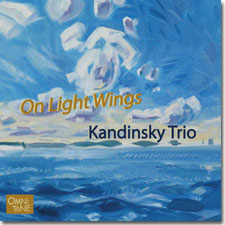 Kandinsky Trio: On Light Wings (OmniTone 15219)
Kandinsky Trio: On Light Wings (OmniTone 15219)
Program Notes for Natural Bridge by John D'earth
Read composer's program notes:
Natural Bridge by John D'earth
Silent Faustus by John D'earth
Piano Quartet ("On Light Wings") by Gunther Schuller
[Composed 2001]
Natural Bridge attempts to combine the languages and procedures of two musical worlds: classical/contemporary chamber music and what is inadequately referred to as "jazz." These worlds have not often co-mingled but in the minds of those who love both worlds it seems, and sounds like, a natural combination. Perhaps one discovers, as this combination is explored, that these two musical worlds are not so very different, after all; that they invite each other in and, by reciprocal influence, suggest new directions and possibilities.
That jazz musicians are largely understood as basing their music on improvisation, and chamber musicians are not, isn't the real crux of the problem to be solved in bringing these two worlds together. Perhaps any perceived problem involves the mistaken idea that jazz is wholly intuitive and emotional (it isn't) and that the demands of performing Beethoven or Bartok, are purely intellectual and technical (they aren't). And it certainly is related to the fact that jazz has a "feel," that it "swings," and that no one has been able to define exactly what that means (the most earnest and technical explanations usually being the least useful) so that notation becomes inadequate to express the rhythmic subtleties and bent tones of the music.
However, it is not always easy to get a good reading of these "rhythmic subtleties and bent tones" even if they sound right in one's head, because most classically-trained musicians have not been exposed to jazz and jazz performance or have actively resisted such exposure. This is where the Kandinsky Trio comes in. Not only have they performed jazz music, but also they have assumed a mission of stretching themselves and the notion of what a chamber ensemble is, and could be, commissioning works that require them to discover new contexts for their individual and collective voices. They are eager collaborators who have been willing to participate in and affect the creation of this piece. I cannot count the times that Alan Weinstein was willing to talk with me and make suggestions that moved the composition forward. In rehearsals each member of the Trio exhibited this same openness, resourcefulness, and enthusiasm for challenges. I came away from every rehearsal newly inspired to write for them. I am deeply grateful for their help, hard work, and encouragement.
The Trio is joined by Kurt Rosenwinkel on guitar and Paul Langosch on acoustic bass. The artistry with which these two musicians interact makes Natural Bridge a possibility. Kurt is one of the foremost guitar and compositional voices of contemporary jazz. Paul performed for many years with Tony Bennett and is much in demand as a jazz bassist and soloist. Between them they create a natural, swinging environment in which the music of Natural Bridge can unfold.
Natural Bridge for piano trio, bass, and jazz guitar
Three Preludes - Why three preludes? Originally there were two. The two preludes are intended to delineate the poles of the piece by contrasting two sides of improvised music: the rhythmic or groove element (the "burning" side of jazz or fusion or bluegrass or gypsy violin music or North Indian raga, etc.) and the romantic, harmonic, almost classical world of the jazz ballad. Kurt added a solo improvisation between them that stands alone and creates a natural bridge, if you will, between the two contrasting statements. Now there are three preludes.
N'goni — The ngoni is a plucked string instrument used by the djeli in the ancient Sudanese kingdom of Segu. These African bard-historians with hereditary ties to noble families sang the histories, genealogies and exploits of kings, heroes and commoners, accompanying themselves on the ngoni. Like Homer they were musical storytellers. The title, Ngoni, reflects the Africanate polyrhythms and call-and-response patterns of the movement and makes reference to the fact that the Kandinsky Trio has commissioned and recorded a work for trio and storyteller, Tales of Appalachia, by Mike Reid.
Polysketch presents the Kandinsky Trio alone and is based on a sixteen-measure, across-the-barline rhythmic figure in the piano that repeats while the strings fulminate in a progressively lengthening line.
Quist is an invented or found word that means "that which you will hear at this point in the music." It is Dionysian in spirit, combining "quest" and "twist." It's party music. It's a jam.
Scherzo — This movement is called The Thread for two reasons: because the long unison line seems to unwind as from a spool and because it was in the working out of this section that the whole piece came into focus. It comprises all the elements of the piece: ensemble playing represented by the unison line with forays into small, individual tunes that later become the basis of the ABC structure that generates Kurt's solo improvisations; a strong rhythmic and groove consciousness, throughout, as represented by the salsa montuno in the piano, the open Latin bass lines improvised by Paul and the jazz waltz which evokes the standard tunes that form such an important part of the jazz repertoire; also the spirit of playfulness: it's a scherzo.
Chromaticus — A fast, hard-bop blues, the last movement is a tour de force of swing and teamwork, especially between the guitar and the bass. The strings are performing background figures that might have come from the early Count Basie Band. And the piano/guitar unison on the "head" is astounding and impeccable.
Program notes by John D'earth
March 1st, 2013
Charlottesville, VA
Natural Bridge is dedicated to the loving memory of Jenny Smyth.
| Buy On Light Wings now at the OmniTone store. |
©2018 OmniTone
